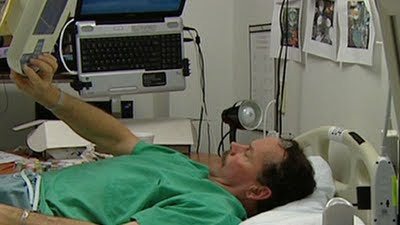While I'm never enamored of how news can tend to trivialize the research experience and all it entails in terms of space flight simulation, I almost always get over it long enough to enjoy any press for the NASA medical studies! The most recent film broke new ground!
For all the new readers who joined me in 2010-11, I started this whole social media bit by accident after doing two bedrest studies myself, one in head-down tilt micro-gravity, and one in up-tilt lunar gravity. I documented my experiences of playing fake Astro-NOT, while scientists tested their various contraptions, or examined my bones and muscles for changes.

Now, however, a new component has been added to the current studies. Participants in iRATS and other upcoming campaigns get to use the eZLS or enhanced Zero-Gravity Locomotion Simulator, a wall-mounted treadmill that simulates space exercise. Of course, astronauts exercise for many hours per day while in space, but it's still a challenge to maintain bone density and muscle tone in weightlessness. Gadgets such as these on Earth help fine tune new possibilities for the space station.
This television broadcast on the ABC nightly news featured the head project scientist Ronita Cromwell, whom I've interviewed before about these amazing studies; our old friend and physical trainer Brent; some ISS footage of exercise machines versus those used on Earth –- all in all, a great range of what the projects are all about.
WFAA Dallas Channel 8 Story by David Schecter
Featuring Gary Conway (Seattle) and Michael Asaf (Houston)
But... "Mad Science treadmill"?? Well, I've heard worse descriptions. Realism is more beneficial to folks who hope to apply for a chance to be part of these programs, designed to result in, as they said, "Healthier astronauts through rigorous scientific research." Well said.
But was it truly a "mentally and physically grueling" study? Not really. I took those same horizontal showers for two months myself, and they were not that difficult. Humans are highly adaptable creatures; you deal with it, you practice, you become adept, and it becomes routine. Every day isn't a rainbow, but neither is every task so grinding that you cannot function happily; like most things in life, the truth is somewhere in between.

I've seen people make remarks about side effects that aren't true either; when the article accompanying this film was released online, someone commented that "you wouldn't even be able to walk afterward." Not so. Walking was stiff and achy for awhile, but healing is a rather swift affair. With regular exercise, I was back up to running daily miles in less than a month!
If you asked either of these chaps after their study stints... they'd very likely say the same. In fact, Gary and Michael, feel free to weigh in around August or so to back me up, LOL!




